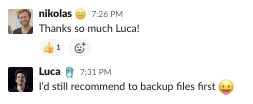This repository contains the source code and the content for the Prisma documentation.
New contributors are welcome! Read through the contributing guide to learn how you can contribute to the Prisma documentation.
- Clone this repository.
- On your computer, open a terminal window in the repository's directory.
- Run the following commands:
cd docs
npm install
npm run start
Be sure to also test building the static site:
npm run clean && npm run build
npm run serve
To prettify or format the code, run:
npm run format
Please note that .md and .mdx files are not formatted by Prettier because they are written in MDX 3 which Prettier does not support.
Visit http://localhost:3000 to view the app.
Write MDX files in content folder.
Most frontmatter for the docs are the same as Docusaurus Frontmatter. There are some differences due to legacy frontmatter which are handled here.
When possible, avoid using custom frontmatter fields and use the default ones available via Docusaurus.
All files/folders in the context are prefixed with a position which indicates the order in which they appear in the sidenav on the docs website. This makes it cumbersome to insert, move and delete files because the positions of a number of other files (if not all) in the same folder might need to be adjusted. Thanks to Luca Steeb, you can perform these operations with a dedicated CLI called mdtool.
First, install wget:
brew install wgetThen use wget to install mdtool:
wget https://gist.githubusercontent.com/steebchen/bd085ebde1fcf4242e3fdd0df4d202a6/raw/c04e3d262eb6a302a9fab98f6428fec9329681e2/mdtool -qO /usr/local/bin/mdtool
chmod +x /usr/local/bin/mdtoolmdtool insert 3
mdtool swap A B
mdtool move A B
mdtool remove 4
Make place for a new file at given index and increment all numbers by one after that index:
$ mdtool insert INDEX
# e.g.:
$ mdtool insert 2
# Result: for files 01-a, 02-b, 03-c, and 04-d; 03-c is renamed to 04-c and 04-d is renamed to 05-d so you can create a new file at index 2
Swap two files; specify both filenames (prefix numbers get automatically adjusted):
$ mdtool swap FILENAME1 FILENAME2
# e.g.:
$ mdtool swap 03-file1.mdx 07-file2.mdx
# Result: Files are now named: 03-file2.mdx 07-file1.mdx
Move a given file to another given index
$ mdtool move FILENAME INDEX
# e.g.:
$ mdtool move 05-file.mdx 2
# Result: 05-file.mdx is move to 02-file.mdx, plus previous files 02-*, 03-*, 04-* are incremented
Shift all other items by -1 at a given index:
$ mdtool remove INDEX
# e.g.:
$ mdtool remove 2
# Result: 01-a, 02-b, 03-c, 04-d becomes 01-a, 02-b, 02-c, 03-d; 02-b is supposed to be manually deleted




















